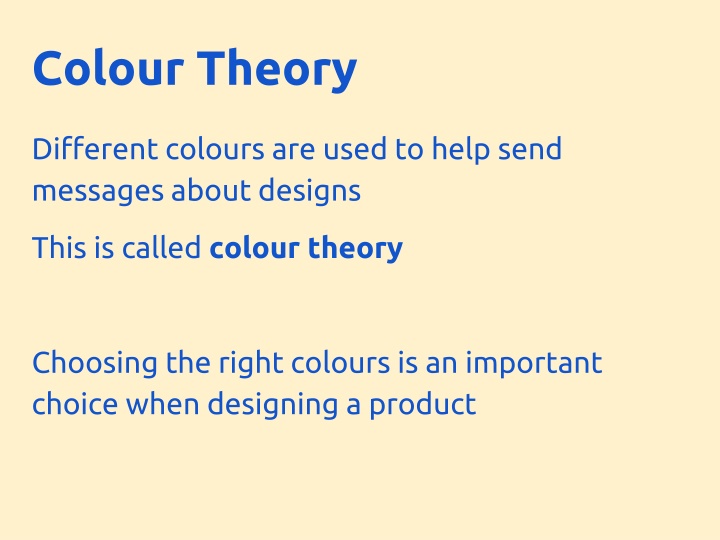
Using Colour Theory in Design for Effective Communication
Colour theory is essential in design as different colours convey various messages. Learn how to choose colours to communicate effectively in your product design. Explore the meanings of colours like red, yellow, green, blue, purple, and pink, and how they impact the viewer's perception and emotions.
Download Presentation

Please find below an Image/Link to download the presentation.
The content on the website is provided AS IS for your information and personal use only. It may not be sold, licensed, or shared on other websites without obtaining consent from the author. If you encounter any issues during the download, it is possible that the publisher has removed the file from their server.
You are allowed to download the files provided on this website for personal or commercial use, subject to the condition that they are used lawfully. All files are the property of their respective owners.
The content on the website is provided AS IS for your information and personal use only. It may not be sold, licensed, or shared on other websites without obtaining consent from the author.
E N D
Presentation Transcript
Colour Theory Different colours are used to help send messages about designs This is called colour theory Choosing the right colours is an important choice when designing a product
Danger, anger, or romance. A high energy colour that reflects urgency, which is why it is often used to symbolise sales and reductions in price. It is bold, brash, and catches the eye.
An energetic colour, symbolise happiness, or even vitality. Can also denote urgency, so is often used to create a 'Buy it Now' call to action.
Youthful and optimistic, vibrant tones of yellow can make your website look fresh and grab your audience's attention. The negative connotation of yellow is that it can sometimes be seen as a deceitful colour.
Symbolises nature when used for beauty products, or can be a symbol of wealth and security. It is one of the easiest colours for the eye to process.
Shades of blue are often used to create a sensation of knowledge, trust and brand loyalty. Many businesses and banks, for example, use blue in their web design to give an impression of solidity and gravitas.
Purple is often associated with royalty and affluence, so is often used by websites to give the impression of luxury. It is also used in the world of retail and beauty to soothe and calm, which is often why it is featured on anti-aging products.
Youthful, fun, and exciting; pink can symbolise a whole host of emotions. It is often used in websites aimed at young women and mothers. It is romantic and feminine so has a very clear target market in mind.
A neutral colour, white reflects purity and cleanliness. Designers talk of using 'white space' to enhance their work and guide the eye. This colour is fresh, open, and inviting, making it a great choice for an eCommerce website.
Black is often seen as a powerful, strong colour; one that is frequently used for luxury products. On the negative side it can seem void of emotion and even symbolise death.
Grey is a neutral colour, and one that can seem conservative and formal. Websites use this colour to show their authority and reflect the high quality of their products. It is mainly used as a background colour because it is devoid of any warmth.
Dependable, natural and stable; brown is a colour that divides opinion. Some see it as a dull colour to be avoided while others will capitalise on the fact it can portray a website as wholesome and reliable.
Colour Theory Make sure you can read your text on the background colour This is called colour contrast and is easiest with light background colours Be careful of colour blind combinations - red/green and blue/yellow are particular problems
